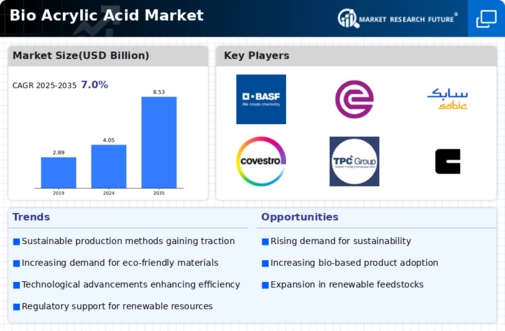Market Growth Projections
The Global Bio Acrylic Acid Market Industry is poised for substantial growth, with projections indicating a market size of 4.05 USD Billion in 2024 and an anticipated increase to 8.53 USD Billion by 2035. This growth trajectory suggests a compound annual growth rate (CAGR) of 7.0% from 2025 to 2035, reflecting the increasing adoption of bio acrylic acid across various industries. The expanding applications, coupled with technological advancements and regulatory support, are likely to contribute to this upward trend, positioning bio acrylic acid as a key player in the global chemical market.
Growing Demand for Sustainable Products
The Global Bio Acrylic Acid Market Industry is witnessing an increasing demand for sustainable and eco-friendly products. As consumers become more environmentally conscious, industries are shifting towards bio-based alternatives. Bio acrylic acid, derived from renewable resources, offers a lower carbon footprint compared to its petroleum-based counterparts. This shift is evident in various applications, including adhesives, paints, and coatings, where manufacturers are actively seeking sustainable solutions. The market is projected to reach 4.05 USD Billion in 2024, reflecting the growing preference for bio-based materials in diverse sectors.
Expanding Applications Across Industries
The versatility of bio acrylic acid is a key driver for the Global Bio Acrylic Acid Market Industry. Its applications span various sectors, including textiles, construction, and personal care products. In textiles, bio acrylic acid is utilized in coatings and finishes, enhancing fabric performance and durability. In construction, it serves as a binder in paints and adhesives, contributing to improved product sustainability. The growing adoption of bio acrylic acid in these diverse applications is expected to propel market growth, as industries increasingly prioritize sustainable materials to meet consumer demands.
Rising Awareness of Environmental Impact
Increasing awareness of environmental issues is shaping consumer preferences and driving the Global Bio Acrylic Acid Market Industry. As individuals and businesses recognize the detrimental effects of conventional chemicals on the environment, there is a noticeable shift towards bio-based alternatives. This heightened awareness encourages manufacturers to invest in bio acrylic acid production, aligning their offerings with consumer values. Consequently, the market is likely to experience robust growth as more companies adopt bio acrylic acid in their product lines, responding to the demand for environmentally friendly solutions.
Regulatory Support for Bio-based Chemicals
Government regulations promoting the use of bio-based chemicals significantly influence the Global Bio Acrylic Acid Market Industry. Policies aimed at reducing greenhouse gas emissions and encouraging sustainable practices create a favorable environment for bio acrylic acid production. For instance, various countries have implemented incentives for manufacturers to adopt bio-based alternatives, aligning with global sustainability goals. This regulatory support not only enhances market growth but also encourages innovation in bio acrylic acid applications. As a result, the market is expected to expand, with projections indicating a rise to 8.53 USD Billion by 2035.
Technological Advancements in Production Processes
Innovations in production technologies are driving the Global Bio Acrylic Acid Market Industry forward. Advances in fermentation processes and biocatalysis have improved the efficiency and cost-effectiveness of bio acrylic acid production. These technological developments enable manufacturers to produce bio acrylic acid at competitive prices, making it a viable alternative to traditional acrylic acid. Furthermore, ongoing research into optimizing production methods is likely to enhance yield and reduce waste, contributing to the overall growth of the market. As these technologies mature, they may play a crucial role in meeting the projected CAGR of 7.0% from 2025 to 2035.






















